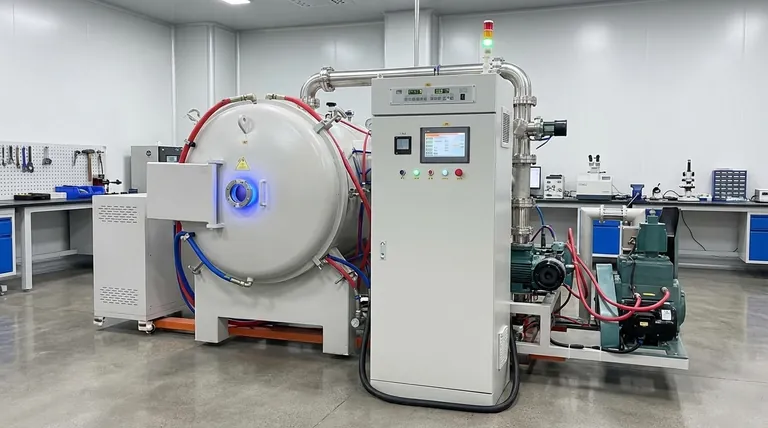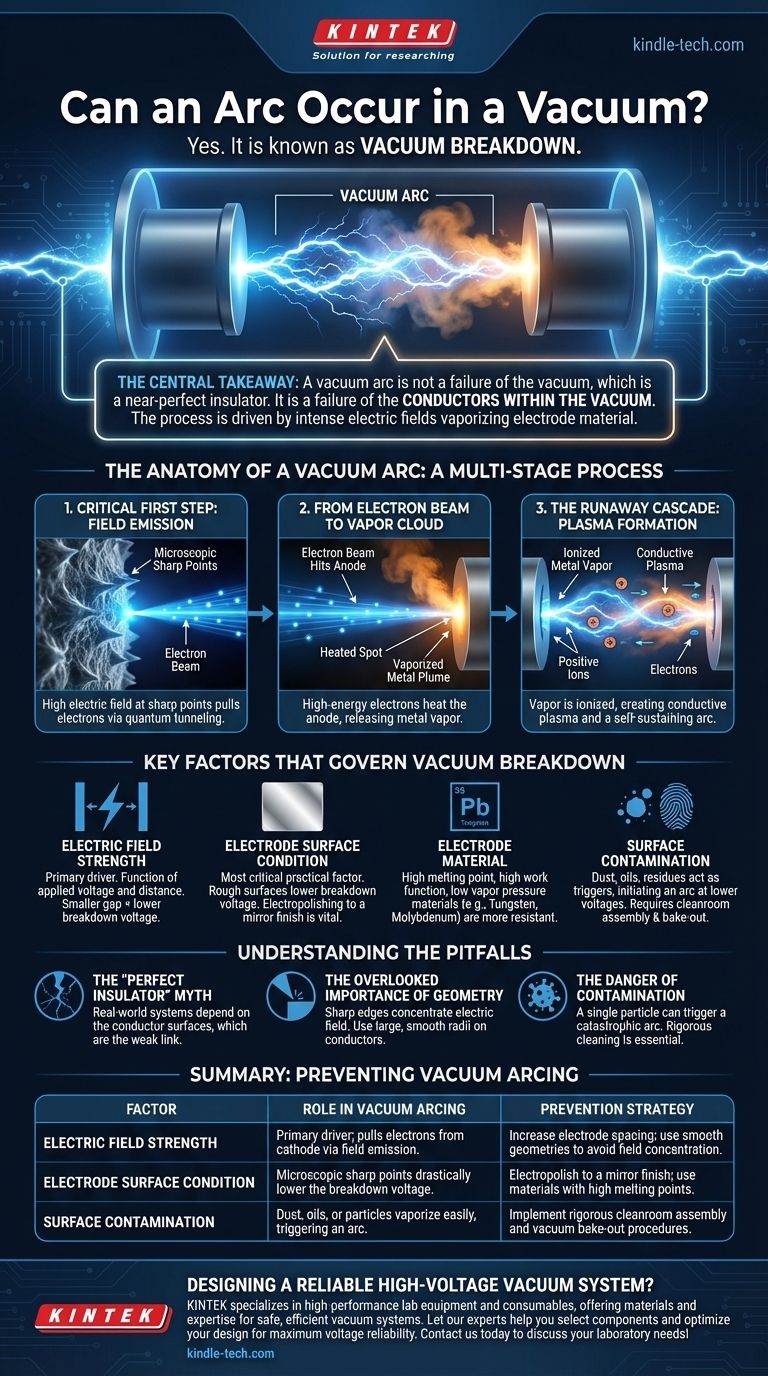一般的な直感に反して、電気アークは真空中で確実に発生します。 この現象は真空破壊として知られ、空気中のアークとは根本的に異なります。周囲のガスが破壊されるのではなく、高い電界が電極材料自体をアークの発生源とし、気化した金属の導電性チャネルを生成します。
重要な点は、真空アークはほぼ完璧な絶縁体である真空の故障ではないということです。それは真空内の導体の故障です。このプロセス全体は、電界が非常に強くなり、電子を引き裂き、電極表面から直接材料を気化させて、アークを形成するために必要な媒体を作り出すことによって駆動されます。
真空アークの構造
真空アークを防ぐ方法を理解するには、まずその独特なライフサイクルを理解する必要があります。これは、電極が自身の「燃料」を提供する多段階プロセスです。
最初の重要なステップ:電界放出
プロセスは負極(陰極)の表面で始まります。高度に研磨された表面であっても、微細な鋭利な点や「ひげ」が存在します。
高い電界はこれらの微小な点に集中します。電界が十分に強い(1メートルあたり数百万ボルト)場合、ファウラー-ノルドハイムトンネル効果と呼ばれる量子力学的効果により、金属表面から直接電子を引き出すことができます。
電子ビームから蒸気雲へ
これらの解放された電子は、高電圧によって真空ギャップを横切って加速され、集束されたビームを形成します。
この高エネルギー電子のビームは正極(陽極)に衝突し、小さなスポットを急速に加熱します。エネルギーが十分であれば、このスポットは沸点まで加熱され、気化した金属のプルームを真空ギャップに放出します。
暴走連鎖反応:プラズマ形成
この新たに生成された金属蒸気の雲が、不足していた要素です。電界放出された電子は、これらの金属原子と衝突してイオン化することができます。
このイオン化により、導電性プラズマ(正の金属イオンとさらに多くの自由電子の混合物)が生成されます。正イオンは陰極に向かって加速され、陰極に衝突してさらに加熱、スパッタリング、そしてさらに多くの電子の放出を引き起こします。これにより、輝くアークとして見える自己持続的な暴走連鎖反応が生まれます。

真空破壊を支配する主要因
破壊電圧がかなり予測可能な空気中とは異なり、真空破壊はシステムの条件と準備に大きく依存します。
電界強度
これが主要な駆動要因です。これは印加電圧と電極間の距離の両方の関数です。より狭いギャップでは、同じ臨界電界強度を達成するためにより低い電圧が必要です。
電極表面の状態
これはおそらく最も重要な実用的な要因です。粗い、研磨されていない、または機械加工された表面には、電界放出を開始するために必要な電圧を劇的に低下させる微細な鋭利な点が存在します。このため、高電圧真空用の部品は、しばしば鏡面仕上げに電解研磨されます。
電極材料
金属の選択が重要です。高融点、高仕事関数、低蒸気圧の材料(タングステンやモリブデンなど)は、アルミニウムや銅のような材料よりもアーク放電に強いです。
表面汚染
ほこりの粒子、指紋からの油、残留洗浄溶剤など、あらゆる異物は電子に衝突すると容易に気化します。これらの汚染物質は「引き金」として機能し、清浄な電極材料が許容するよりもはるかに低い電圧でアーク放電を開始させます。
落とし穴を理解する
真空中で高電圧を設計するには、ガスの特性から、極度のストレス下にある固体材料の特性へと思考を転換する必要があります。
「完璧な絶縁体」神話
完璧な真空は完璧な絶縁体ですが、現実のシステムはそうではありません。システムの絶縁性は、その中の導体の表面の良さに依存します。電極は常に弱点です。
見過ごされがちな形状の重要性
エンジニアは部品の形状にこだわる必要があります。導体上の鋭いエッジや角は電界を集中させ、電界放出の潜在的な場所となります。すべての高電圧導体は、大きく滑らかなR(半径)を持つべきです。
汚染の危険性
大気中のシステムでは、少量のほこりは無害かもしれません。高電圧真空システムでは、単一の微細な粒子が壊滅的なアークの種となる可能性があります。このため、厳格なクリーンルームでの組み立てと真空ベークアウト手順(真空下でシステムを加熱して汚染物質を追い出す)が標準的な慣行となっています。
設計における真空アークの防止方法
破壊を防ぐための戦略は、システムの主要な要件に直接依存します。
- 電圧の信頼性を最大化することが主な焦点である場合:電極材料の選択(例:タングステンやステンレス鋼)と、微細な鋭利な点を除去するための電解研磨を含む綿密な表面処理を優先します。
- 実用的なシステムを設計することが主な焦点である場合:すべての導体に大きく滑らかなRを使用し、全体的な電界を低下させるために理論上の最小値よりも十分な間隔を確保することで、部品の形状に焦点を当てます。
- 長期的な運用安定性が主な焦点である場合:システムを密閉または操作する前に、すべての表面汚染物質と吸着ガスを除去するために、厳格な洗浄と真空ベークアウト手順を実施します。
最終的に、真空アークのリスクを管理することは、空隙そのものではなく、空隙内の表面を制御することにかかっています。
要約表:
| 要因 | 真空アークにおける役割 | 予防戦略 |
|---|---|---|
| 電界強度 | 主要な駆動要因。電界放出を介して陰極から電子を引き出す。 | 電極間隔を広げる。電界集中を避けるために滑らかな形状を使用する。 |
| 電極表面の状態 | 微細な鋭利な点が破壊電圧を劇的に低下させる。 | 鏡面仕上げに電解研磨する。高融点の材料を使用する。 |
| 表面汚染 | ほこり、油、粒子が容易に気化し、アークを引き起こす。 | 厳格なクリーンルームでの組み立てと真空ベークアウト手順を実施する。 |
信頼性の高い高電圧真空システムを設計していますか?
真空アークを防ぐには、電極材料、表面仕上げ、および組み立ての清浄度を正確に制御する必要があります。KINTEKは高性能ラボ機器と消耗品を専門とし、お客様の真空システムが安全かつ効率的に動作するための材料と専門知識を提供します。
当社の専門家が、お客様の特定のラボニーズに合わせて適切なコンポーネントを選択し、最大の電圧信頼性を実現するように設計を最適化するお手伝いをいたします。 今すぐお問い合わせください!
ビジュアルガイド




















